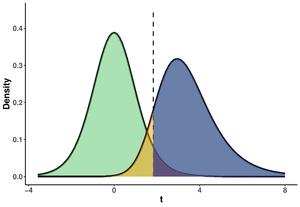
Power of a One-Sample t-Test
(0)Explore the power of a one-sample t-test and its relationship with significance level, effect size, and sample size using an interactive online resource.
Prerequisite Knowledge
- Know that a one-sample t-test uses a random sample to determine whether the population mean is different from a specified value
- Describe the role of the null and alternative hypotheses in a hypothesis test
- Familiarity with the term significance level in the context of a t-test
- Have working knowledge of the Normal distribution and its two parameters, the mean and variance
Learning Objectives
- Summarize how the power of a one-sample t-test is affected by the difference in means between the two populations; variance of the population; effect size; significance level; and sample size
- Describe how to use the relationship between power, significance level, sample size, and effect size to find the required sample size for a t-test with specific requirements using an online interactive resource
Description
This activity is based on an interactive online resource (https://shiny-apps.stat.ubc.ca/FlexibleLearning/Power/) developed at the University of British Columbia. The goal of the activity is for students to develop an intuition about the power of a hypothesis test, as well as the relationship between power and significance level, effect size, and sample size, in the context of a one-sample, one-sided t-test. Students are prompted to set multiple values of the aforementioned settings and to anticipate how the power of the resulting test is affected, and finally to then observe this effect in the resource. The activity also includes a sample size calculation section and an applied exercise that show the students how all these concepts and their relationships can be used in practice to design a simple experiment.
Suggested Uses, Tips and Discoveries
This activity can be used as an introduction to power, specifically in the context of a one-sample, one-sided t-test. If the concept has already been introduced in the course, this activity can also be used to enhance students’ knowledge. However, this activity should not be used as an introduction to hypothesis testing in general, or even t-tests in particular. Students should already have some knowledge of hypothesis testing, as specified in the prerequisites section. This activity is also ideal for introducing students to the concept of effect size and sample size calculation in practice.
The activity is appropriate for all class sizes and formats and can be implemented in multiple ways—as an in-class activity, in a lab, as a homework assignment, amongst others.
The activity will take a long time to complete (the full version of the activity takes around 1.5 hours). The activity can be split into parts, such as leaving the applied exercise as a homework assignment and completing the rest of the activity in class or lab beforehand. Furthermore, some parts of the activity can be omitted entirely, such as the effect size section. If a section is omitted, however, the instructor must be sure to remove other mentions of the removed section throughout the activity. As an example, if the effect size section is removed, the wording in sections VI and VII must be modified so that the difference in means is referred to instead of the effect size. For this purpose, the activity is downloadable as a Word document which can be modified.
Creator
- Di-Luvi, Gian Carlo
Resource Type
Related Resource
Date Approved
Access
Everyone
https://statspace.elearning.ubc.ca/handle/123456789/333
Comments
Ratings in detail